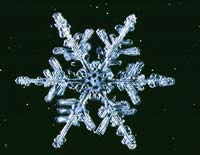Scientists catch cold

Snow may chill us through one or more receptors <br>© SPL
New skin receptor is the tip of the iceberg.
A snowball in the face or a chilly breeze around the ankles opens a molecular trap door in our skin’s nerve cells, two studies now show1,2. A third suggests that this, the first cold sensor to be identified, is just the tip of the iceberg3.
How sensory neurons detect a drop in temperature is very hard to study because it affects so many cell processes.
David Julius of the University of California, San Francisco, and his colleagues resorted to using menthol, which has the same effects on cold-sensitive nerves as a drop in temperature. “Technically it is much easier to use a chemical,” says Julius.
Julius’s team took genes for a host of unknown receptors normally found on the surface of sensory nerve cells and inserted them into human kidney cells1. The confused kidney cells dutifully produced the receptors on their surface, which the team then exposed to menthol.
One receptor fitted the bill perfectly. It now has the catchy name cold- and menthol-sensitive receptor (CMR1); it is an ion channel. It opens in the presence of menthol, allowing potassium and calcium ions to flood into a nerve cell. Cooling has the same effect on it.
In a separate study, using different methods, Ardem Patapoutin at the Scripps research Institute in La Jolla, California identified another, possibly the same, cold receptor. While it’s too early to tell, Patapoutin says he’d “bet they’re the same”.
A specific receptor for cold is a surprise, says Amy MacDermott a physiologist at Columbia University in New York. “It is totally unknown and extremely interesting,” she says. Given the difficulties of studying the mechanisms of cold detection, Julius’s team “makes a very good case,” she says.
Cold comfort
A single sensor doesn’t explain everything. Félix Viana, a physiologist at Miguel Herná¡ndez University in Alicante, Spain, and colleagues have found that cold-sensitive nerves have a unique number of the ordinary potassium ion channels that are common to all nerves. “This specialized blend of ion channels makes them sensitive to cooling,” he says.
The Spanish group looked for a specific receptor but didn’t find one, says Viana. But “just because you don’t find something it doesn’t mean it’s not there,” he admits.
The three studies present new and different explanations for how we detect cold. Physiologist Arthur Craig at Barrow Neurological Institute in Phoenix, Arizona, wonders whether a lone cold sensor would be diverse enough to explain the range of temperatures that our skin is sensitive to. Viana’s model accounts for this, he points out.
Like any well-engineered system, the body’s temperature-sensing network almost certainly has back-up mechanisms. Says Craig: “Biology is based on redundancy” – the teams are probably just working on different parts of the problem. “We can be sure that the biology is more complex than either study,” he adds.
References
- McKemy, D. D., Neuhausser, W. M. & Julius, D. Identification of a cold receptor reveals a general role for TRP channels in thermosensation. Nature advance online publication, (2002).
- Peier, A. M. et al. A TRP channel that senses cold stimuli and menthol. Cell advance online publication, (2002).
- Viana, F., de la Peña, E. & Belmonte, C. Specificity of cold thermotransduction is determined by differential ionic channel expression. Nature Neuroscience advance online publication, (2002).
Media Contact
More Information:
http://www.nature.com/nsu/020204/020204-14.htmlAll latest news from the category: Life Sciences and Chemistry
Articles and reports from the Life Sciences and chemistry area deal with applied and basic research into modern biology, chemistry and human medicine.
Valuable information can be found on a range of life sciences fields including bacteriology, biochemistry, bionics, bioinformatics, biophysics, biotechnology, genetics, geobotany, human biology, marine biology, microbiology, molecular biology, cellular biology, zoology, bioinorganic chemistry, microchemistry and environmental chemistry.
Newest articles

Properties of new materials for microchips
… can now be measured well. Reseachers of Delft University of Technology demonstrated measuring performance properties of ultrathin silicon membranes. Making ever smaller and more powerful chips requires new ultrathin…

Floating solar’s potential
… to support sustainable development by addressing climate, water, and energy goals holistically. A new study published this week in Nature Energy raises the potential for floating solar photovoltaics (FPV)…

Skyrmions move at record speeds
… a step towards the computing of the future. An international research team led by scientists from the CNRS1 has discovered that the magnetic nanobubbles2 known as skyrmions can be…





















